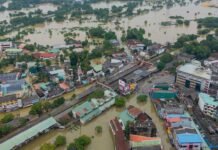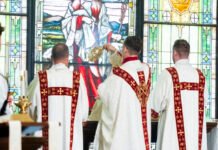The Archbishop of Canterbury has walked back his instructions to clergy not to enter their churches during the COVID-19 pandemic, telling the BBC his words were merely guidance, not a binding directive.
The Most Rev. Justin Welby’s statement on BBC1’s The Andrew Marr Show broadcast on Easter Sunday followed a week of public dissent from clergy across the church theological spectrum, culminating in negative news coverage in The Times and Telegraph the day before the interview.
On 24 March 2020 the Archbishop of Canterbury and the Archbishop of York, the Most Rev. John Sentamu, published a letter to the clergy of the Church of England following Prime Minister Boris Johnson’s call for houses of worship to be closed temporarily to halt the spread of the Coronavirus.
The Archbishops wrote: “Our church buildings must now be closed not only for public worship, but for private prayer as well, and this includes the priest or lay person offering prayer in church on their own.”
Diocesan bishops also issued their own pastoral admonitions to parish clergy. The Bishop of Rochester, the Rt. Rev. James Langstaff, wrote to office holders in his diocese saying the bishops had discussed the prime minister’s directive and had agreed to abide with his request.
“This means that all our places of worship are now to be fully closed with immediate effect – that is, for private prayer and daily offices as well as for public worship,” Bishop Langstaff wrote.
He went on to say: “All worship and prayer is, therefore, now in the home, on the phone or online. This includes for baptisms and weddings, which are now explicitly suspended in line with the Prime Minister’s statement.”
Adding: “I do need to say that for the clergy, failure fully to implement these arrangements could be deemed to be a disciplinary matter – it is that serious.”
The legality of the bishops’ order was challenged by clergy, who pointed out canon law conflicted with their directions. In the Telegraph the rector of St Bartholomew the Great, in London, the Rev Marcus Walker was quoted as saying: “We’re expected to say morning and evening prayer in our churches every Sunday and to celebrate communion — that’s the law. Do the bishops have a right to order us not to do our legal duty? Every canon lawyer I have spoken to says ‘No’.”
The Telegraph also cited the Rev. James Paice, rector of St Luke’s Wimbledon, who pointed out the logical inconsistency of the archbishops’ missive. “If people can go to supermarkets and get food and stand less than two meters apart from each other, why can’t clergy go into an empty building on their own?”
In his Easter Day interview, Archbishop Welby responded to the criticisms telling Andrew Marr: “we have given guidance, not instruction.”
He went on to say: “no, we haven’t given an instruction; so we haven’t broken canon law. We have said: ‘This is how you care for your flock and share in the privations of the flocks and share in the suffering of the nation and set an example, and care for others and look after them. Stay at home, protect the NHS, save lives. It’s not complicated.”
Archbishop Welby said the decision to close churches had been taken collectively by the bishops after “much pain and much thought and much prayer, and after much discussion; so it’s not just a single person making up their mind on the spur of the moment.”
While he was not happy with the situation, he noted: “the reality is we’re here to set an example, to share in the deprivation of the things we like doing, to care for others. It’s not about us; it’s about being the Church for England, not just the Church of England. . .
“The church buildings are closed, and I love the church buildings, but the Church is emphatically not closed — it’s probably busier than it’s ever been.”
Asked about Mr. Paice’s comment as to why social distancing worked in supermarkets and not in churches, the archbishop offered an epidemiological explanation. “In practical terms, it’s very straightforward: that people when they go into a church leave traces on the pews, on the places they’ve been. If someone goes to the same place, within a matter of days, and the virus has been left there, they can pick it up. That’s the practical answer, and it’s a very straightforward one.”
While studies remain on-going as to the mode of transmission of COVID-19, the Centers for Disease Control and Prevention (CDC) have said COVID-19 is a respiratory virus, and is mainly transmitted between people through “respiratory droplets” when symptomatic people sneeze or cough. This guides the CDC’s advice to maintain at least a 6-foot distance between you and other people.




And another feckless leader has to retreat into a safe space.
…and after Easter!
“Our church buildings must now be closed…” sounds very much like a directive rather than guidance.
If I had spoken thus, and then denied that I had said it, I would be accused, in Bernard Ingham’s famous phrase, of “… being economcal with the actualite.”.
This man is yet again, caught out in a silly and obvious, er, verbal mishap. And of course he has form: for years he has been happy to say one thing to one group and the polar opposite to other groups in the church. It is absurd that he thinks this will do anything other than discredit him and, by extension, his office. There’s a frightened world out there that needs the Gospel, plain, straight and simple, not this nonsense.
And that is his most important, arguably his only, job, one for which his predecessors have literally given their lives.
He is not elected, he is appointed by the British establishment. Not that election would help, but it does mean that there is no mechanism for his removal, apart from perhaps a strong suggestion from the palace.
And, by recent evidence, we will be faced with more of the same when Colchester becomes York.
Integrity, honesty, sola scriptura?
If these people and their cohort don’t go, Anglicanism will itself go, at least from these islands.
[…] Welby’s description, in a television interview, of the archbishops’ and bishops’ instruction to clergy not to pray in their own churches during the lockdown as no more than […]
[…] Welby’s description, in a television interview, of the archbishops’ and bishops’ instruction to clergy not to pray in their own churches during the lockdown as no more than ‘guidance’ was […]